
A division is a large military unit or formation, usually consisting of between 6,000 and 25,000 soldiers.

A brigade is a major tactical military formation that is typically composed of three to six battalions plus supporting elements. It is roughly equivalent to an enlarged or reinforced regiment. Two or more brigades may constitute a division.
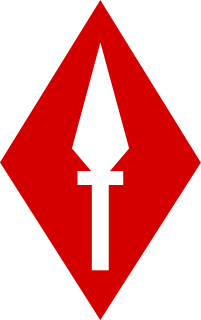
I Corps was an army corps in existence as an active formation in the British Army for most of the 80 years from its creation in the First World War until the end of the Cold War, longer than any other corps. It had a short-lived precursor during the Waterloo Campaign.

The VII Army Corps of the United States Army was one of the two principal corps of the United States Army Europe during the Cold War. Activated in 1918 for World War I, it was reactivated for World War II and again during the Cold War. During both World War II and the Cold War it was subordinate to the Seventh Army, or USAREUR and was headquartered at Kelley Barracks in Stuttgart, West Germany, from 1951 until it was redeployed to the US after significant success in the Gulf War in 1991, then inactivated in 1992.

The 4th Infantry Division was a regular infantry division of the British Army with a very long history, seeing active service in the Peninsular War, the Crimean War, the First World War, and during the Second World War. It was disbanded after the war and reformed in the 1950s as an armoured formation before being disbanded and reformed again and finally disbanded on 1 January 2012.

The French Army, officially the Ground Army to distinguish it from the French Air and Space Force, is the land-based and largest component of the French Armed Forces. It is responsible to the Government of France, along with the other four components of the Armed Forces. The current Chief of Staff of the French Army (CEMAT) is General Thierry Burkhard, a direct subordinate of the Chief of the Defence Staff (CEMA). General Burkhard is also responsible, in part, to the Ministry of the Armed Forces for organization, preparation, use of forces, as well as planning and programming, equipment and Army future acquisitions. For active service, Army units are placed under the authority of the Chief of the Defence Staff (CEMA), who is responsible to the President of France for planning for, and use, of forces.

The 1st Division, formerly known as the 1st Armoured Division, is a division of the British Army. It has recently returned home from being stationed in Germany. Originally formed in November 1937 as the Mobile Division, it saw extensive service during the Second World War and was disbanded afterwards; reconstituted in 1976, it remains in service. It should not be confused with the 1st Infantry Division, a historic Division which was disbanded in 1960.

An Army Group Royal Artillery (AGRA) was a British Commonwealth military formation during the Second World War and shortly thereafter. Generally assigned to Army corps, an AGRA provided the medium and heavy artillery to higher formations within the British Army.

The Land Component is the land branch of the Belgian Armed Forces. The King of the Belgians is the commander in chief. The current chief of staff of the Land Component is Major-General Pierre Gérard.

The Turkish Land Forces, or Turkish Army, is the main branch of the Turkish Armed Forces responsible for land-based military operations. The army was formed on November 8, 1920, after the collapse of the Ottoman Empire. Significant campaigns since the foundation of the army include suppression of rebellions in southeastern Turkey from the 1920s to the present day, combat in the Korean War, the 1974 Turkish invasion of Cyprus and the current Turkish involvement in the Syrian Civil War, as well as its NATO alliance against the USSR during the Cold War. The army holds the preeminent place within the armed forces. It is customary for the Chief of the General Staff of the Turkish Armed Forces to have been the Commander of the Turkish Land Forces prior to his appointment as Turkey's senior ranking officer. Alongside the other two armed services, the Turkish Army has frequently intervened in Turkish politics, a custom that is now regulated to an extent by the reform of the National Security Council. The current commander of the Turkish Land Forces is General Ümit Dündar.

The 8th Armoured Division was an armoured division of the British Army during the Second World War. It was deployed to Egypt in June 1942 but never operated as a complete formation and was disbanded in January the following year.
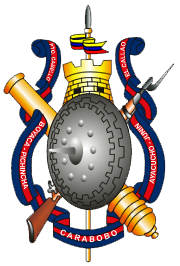
The Venezuelan Army, officially the National Army of the Bolivarian Republic of Venezuela, is one of the six professional branches of the Armed Forces of Venezuela. Also known as Bolivarian Army, its role is to be responsible for land-based operations against external or internal threats that may put the sovereignty of the nation at risk. The army is the second largest military branch of Venezuela after the Bolivarian Militia.

The 10th Armoured Division was an armoured formation of division-size of the British Army, raised during World War II and was active from 1941–1944 and after the war from 1956–1957. It was formed from the 1st Cavalry Division, a 1st Line Yeomanry unit of the Territorial Army (TA) which had previously been serving in Palestine. The division was converted from cavalry to armour and redesignated from 1 August 1941.
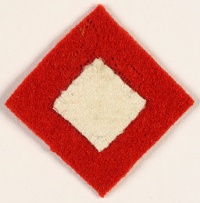
The 42nd Armoured Division was an armoured division of the British Army raised during the Second World War.
The 7th Armoured Division was an armoured division of the French Army. The division was active during the Cold War and some time after the fall of the Berlin Wall, before being disbanded. Its traditions were carried on by the 7th Armoured Brigade.

The 3rd Armoured Division is a unit of the French Army.
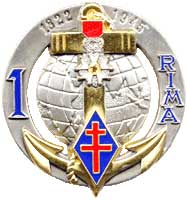
The 1st Marine Infantry Regiment is a French regiment heir of the colonial infantry. The regiment is one of the « quatre vieux » regiments of the Troupes de Marine, with the 2nd Marine Infantry Regiment 2e RIMa, the 3rd Marine Infantry Regiment 3e RIMa, as well the 4th Marine Infantry Regiment 4e RIMa. Along with the 1st Marine Artillery Regiment 1e RAMa and the 2nd Marine Artillery Regiment 2e RAMa, the 1st Marine formed the Blue Division. The 1e RIMa is a light armoured unit, since 1986, alike with the régiment d'infanterie-chars de marine RICM.

The Army de Châlons was a French military formation that fought during the Franco-Prussian War of 1870. Formed in the camp of Châlons on August 17, 1870, from elements of the Army of the Rhin (1870) which the formation was issued from, the Army of Châlons was engaged in combats of Beaumont and Sedan while disappearing during the capitulation of September 2, 1870.
The Division Daguet was a French Army division formed in September 1990 in Saudi Arabia as part of France's contribution to Operation Desert Shield. The French military contribution to the allied cause to liberate Kuwait from Iraqi occupation was named Opération Daguet and its ground part was subsequently named Division Daguet. In French "Daguet" is a young brocket deer.
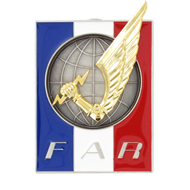
The Rapid Action Force was an army corps of the French Army, created on July 1, 1984 during the reorganization of the later within the law n°83-606 of July 8, 1983 bearing approbation of the military programming for the years 1984 to 1988; the force would have been in means to deploy in Central-Europe and exterior theatres of operations in case of crisis undergone in intermediary conflicts. The force was dissolved in 1999.
















